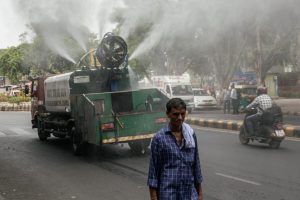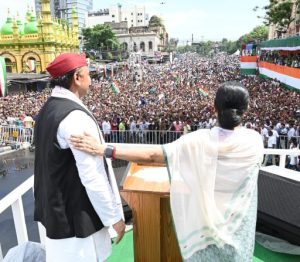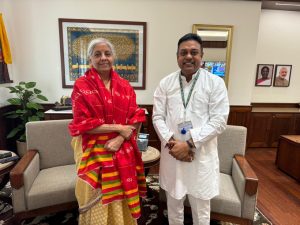India’s G20 Presidency: Agenda for holistic healthcare

By Rahul Kumar Dubey
New Delhi, August 20: Soni Khatoon’s worst night ended with the brightest morning. Khatoon, a native of Motihari, Bihar, was in excruciating agony in her chest, and every day felt like a year to her, with a continual concern for her children’s safety if she did not live.
The condition stayed the same after spending a lot on treatment at a fancy hospital. Thus, when Ayushman Bharat came into picture, under the world’s largest health assurance scheme funded by Government of India, she got her Mitral Valve Replacement, that not only saved her, but also her loved ones that she had been nurturing since years.
The 2019 report of the World Health Organization asserted a mismatch in healthcare spending in tune to global economy, while the former gained more pace than the latter. As per the report, spending on the healthcare amounted to 10 per cent of the global gross domestic product.
While four per cent increase in healthcare spending was noticed in high income countries, the low-and middle-income countries saw an upward trajectory of six per cent, thus posing a burden of out-of-pocket expenditure on the people, thereby compromising their spending affinities, taking a toll on their collective effort to earn more.
While the world was inching ahead on the path of clipping down the effects of Covid-19 through testing, tracking and mass vaccination, the burden of treatment expenses of Covid-19 was still haunting many. Even a strong economy like the United States of America had failed to cover the out-of-pocket expenses of its inhabitants, who faced with a new difficulty in addressing their financial debt accrued while being treated for Covid-19 infection.
While the economic activity was also forced to quarantine along with people since the advent of pandemic, to make things even worse, additional medical debt was ready to haunt a million Americans. For instance, a personal finance company in the U.S.A reported in April 2021 that the customers carried 2.2 billion dollars additional medical debt from January 2020 to March 2021, thereby totaling 47 billion dollars.
The fulcrum of the issue can be carved out of the fact that people resorted to personal loans in order to repay the debts in the U.S.A. As per LendingTree, a finance company in U.S.A, there was 50 per cent higher enquiries of personal loans for medical expenses in the 2020, as compared to the same period during the year 2019.
There are number of events wherein institutional actions were resorted against the people who failed to pay the medical debts. As per the report of Community Service Society, a U.S.A based research and advocacy group, New York’s 55 non-profit charitable hospitals sued almost 4,000 New Yorkers on account of medical debts, despite receiving government funding to offset their losses.
One of the largest non-profit hospitals of New Jersey filed lawsuits to recover 350,000 dollars since public health state of emergency was declared.
In New Jersey, the non-profit hospitals started hiring debt collection firms to file cases against patients whose treatment cost ranged from 15,000 dollars to 16,000 dollars.
The expense of Covid-19 treatment in the U.S.A for people aged between 51 to 60 ran up to 45,650 dollars (approximately), while the households had a median balance of 5,300 dollars and hence its quite evident as to why the people fell into the debt loop of medical expenses.
When the state healthcare infrastructure of U.S.A struggled along with the much hyped Obamacare, accessing the indicators of the world’s largest health assurance scheme funded by Government of India is the need of the hour.
Ayushman Bharat, a flagship scheme that happens to be the world’s largest health assurance scheme of Government of India, was launched as recommended by the National Health Policy 2017, to achieve the vision of Universal Health Coverage (UHC), designed to meet Sustainable Development Goals (SDGs) Target 3.8 and realising the commitment to “leave no one behind”.
Launched in 2018 at the capital city of Jharkhand, who knew that this public health policy will be the first responders in setting up accountability for Sustainable Development Goals during the distressing times of pandemic.
The scheme aimed to provide a financial support of Rs. 5 lakhs to 500 million Indians per year (107.4 million families), irrespective of religion, caste or class. Just within 150 days of its inception, 1.2 million people were treated under the scheme, free of cost, while till February 2022, 2.99 crore people have been hospitalised under the scheme, thus saving the people from the tight grip of medical expenses that could have taken a heavy toll on their expenditure budget, much like that of the U.S.A.
It shall also be noted that nearly a million (8.3 lakhs) Indians got Covid-19 treatment under the Ayushman Bharat scheme, thus saving the most vulnerable from the tiring clutches of the post infection expenses.
While the over-hyped Obamacare required every citizen to buy insurance cover on which the government provided subsidy on premiums, it became a debateable topic in political and civic sphere in U.S.A as to whether it shall be scrapped, while the PMJAY was completely government funded and covered 500 million beneficiaries, larger than the entire population of the U.S.A.
(Views expressed in the article solely belong to author, who is a research fellow with Public Policy Research Centre)







